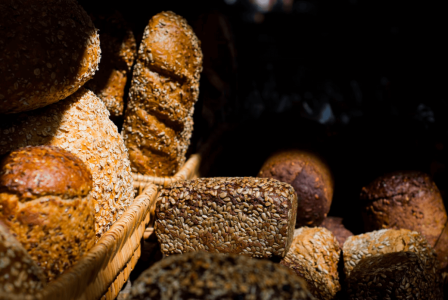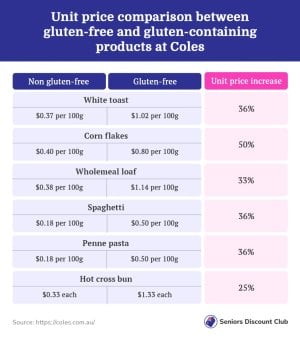The Gluten-Free Tax: Why Are We Paying More?
- Replies 5
Coeliac disease is an autoimmune disorder that causes the immune system to react abnormally to gluten, a protein found in wheat, barley and rye. Over time, this reaction can damage the lining of the small intestine and cause a range of uncomfortable symptoms, including bloating, abdominal pain, and diarrhoea.
The condition is common and is reported to be affecting approximately 1 in 70 Australians. Symptoms can be similar to other digestive disorders, making it difficult to diagnose without a blood test or biopsy.
This is probably why around 80% of people who have the disease remain undiagnosed, putting them at risk of long-term health complications.
While some people may recover from their symptoms without any intervention, others require a strict gluten-free diet to maintain normal bodily functions.
Unfortunately, for those who need to adopt a gluten-free lifestyle, the cost of gluten-free products can be exorbitant compared to their gluten-containing counterparts. This leaves many individuals pondering: why exactly is the price discrepancy so high?

It's a common scenario in Australia that cafes, restaurants, and venues charge an extra fee for gluten-free meals. Whether you're ordering a classic big breakfast, pasta, or even a sandwich, you'll most likely be paying more to avoid wheat.
Unfortunately, this 'gluten-free tax' disproportionately affects individuals with immune conditions who have no choice but to opt for gluten-free options.
According to food experts, the price discrepancy between gluten-free and regular food is staggering. On average, gluten-free food is 7.2 times more expensive than its gluten-containing counterpart.
This means that people who need to adhere to a gluten-free diet are paying significantly more for their meals, which can add up over time.

Sadly, these hikes aren't just limited to restaurant meals. Even when it comes to supermarket shopping, the cost of opting for gluten-free products can be steep.
Becky Excell, a cook who specialises in gluten-free meals based abroad, has pointed out that a grocery bill can be 20% more expensive if you're purchasing food without gluten products. This can make it difficult for those with celiac disease or gluten intolerance to afford the food they need to maintain their health.
Excell has highlighted the stark reality faced by people with coeliac disease, gluten intolerance, or other medical reasons for avoiding gluten. In a TikTok video, she emphasised that for these individuals, choosing gluten-free food isn't a choice - it's a necessity.
She went on to explain that buying basic gluten-free food products often means paying significantly higher prices than regular food.
'That's just how it is when you buy basic gluten-free food products. Gluten-free food is too expensive, and it needs to change,' she argued.
Excell's TikTok video sparked a wave of responses from her followers, who expressed their outrage at the 'obscene' food tax imposed on gluten-free products. Many shared their own experiences of being charged more for allergy-friendly food, such as lactose-free cheese.
Several commenters also highlighted the challenge of budgeting for a gluten-free diet when prices are so much higher than for regular food. It's frustrating to have to pay more for a basic necessity, especially when it's not a choice but a medical necessity.
Moreover, some people felt that the higher cost of gluten-free products didn't always equate to better quality, making the expense even harder to justify.
So, why are gluten-free products more expensive than those containing gluten?
Schär, a leading gluten-free manufacturer, sheds light on some of the reasons behind the high cost of gluten-free products.
One key factor is supply and demand - the market for gluten-free products is much smaller than the market for grain products that contain gluten, so the cost of producing gluten-free items is higher.
Another reason for the high cost is the complex production process required for gluten-free products. From delivery to production to packaging, gluten-free products need to be monitored closely to ensure they meet strict safety standards. Raw materials like rice and maize, which are commonly used in gluten-free foods, are also more expensive than wheat.
Furthermore, the production of high-quality, reliably gluten-free food requires advanced automation and cutting-edge technology, adding to the cost.
All of these factors contribute to the higher price of gluten-free products, making them unaffordable for many who need them for medical reasons.

So there you have it, members! Are you feeling the pinch in your wallet when it comes to buying gluten-free products?
It's no secret that these items can come with a higher price tag, but do you agree that supermarkets are overcharging for them? We'd love to hear your thoughts and experiences in the comments below!
And for those of you who are on a gluten-free diet, we've got some exciting news! Coles has just released a new line of instant noodles that are not only delicious but also gluten-free! If you want to learn more about these mouth-watering options, check out our article by clicking on the link here. Don't miss out on these tasty treats!
The condition is common and is reported to be affecting approximately 1 in 70 Australians. Symptoms can be similar to other digestive disorders, making it difficult to diagnose without a blood test or biopsy.
This is probably why around 80% of people who have the disease remain undiagnosed, putting them at risk of long-term health complications.
While some people may recover from their symptoms without any intervention, others require a strict gluten-free diet to maintain normal bodily functions.
Unfortunately, for those who need to adopt a gluten-free lifestyle, the cost of gluten-free products can be exorbitant compared to their gluten-containing counterparts. This leaves many individuals pondering: why exactly is the price discrepancy so high?

Gluten-free food is, on average, 7.2 times more expensive than regular food. Credit: Unsplash/Wesual Click.
It's a common scenario in Australia that cafes, restaurants, and venues charge an extra fee for gluten-free meals. Whether you're ordering a classic big breakfast, pasta, or even a sandwich, you'll most likely be paying more to avoid wheat.
Unfortunately, this 'gluten-free tax' disproportionately affects individuals with immune conditions who have no choice but to opt for gluten-free options.
According to food experts, the price discrepancy between gluten-free and regular food is staggering. On average, gluten-free food is 7.2 times more expensive than its gluten-containing counterpart.
This means that people who need to adhere to a gluten-free diet are paying significantly more for their meals, which can add up over time.

Many people, especially those with coeliac disease or gluten intolerance, have expressed frustration over the additional cost and called for a change. Credit: Unsplash/James Harris.
Sadly, these hikes aren't just limited to restaurant meals. Even when it comes to supermarket shopping, the cost of opting for gluten-free products can be steep.
Becky Excell, a cook who specialises in gluten-free meals based abroad, has pointed out that a grocery bill can be 20% more expensive if you're purchasing food without gluten products. This can make it difficult for those with celiac disease or gluten intolerance to afford the food they need to maintain their health.
Excell has highlighted the stark reality faced by people with coeliac disease, gluten intolerance, or other medical reasons for avoiding gluten. In a TikTok video, she emphasised that for these individuals, choosing gluten-free food isn't a choice - it's a necessity.
She went on to explain that buying basic gluten-free food products often means paying significantly higher prices than regular food.
'That's just how it is when you buy basic gluten-free food products. Gluten-free food is too expensive, and it needs to change,' she argued.
Excell's TikTok video sparked a wave of responses from her followers, who expressed their outrage at the 'obscene' food tax imposed on gluten-free products. Many shared their own experiences of being charged more for allergy-friendly food, such as lactose-free cheese.
Several commenters also highlighted the challenge of budgeting for a gluten-free diet when prices are so much higher than for regular food. It's frustrating to have to pay more for a basic necessity, especially when it's not a choice but a medical necessity.
Moreover, some people felt that the higher cost of gluten-free products didn't always equate to better quality, making the expense even harder to justify.
So, why are gluten-free products more expensive than those containing gluten?
Schär, a leading gluten-free manufacturer, sheds light on some of the reasons behind the high cost of gluten-free products.
One key factor is supply and demand - the market for gluten-free products is much smaller than the market for grain products that contain gluten, so the cost of producing gluten-free items is higher.
Another reason for the high cost is the complex production process required for gluten-free products. From delivery to production to packaging, gluten-free products need to be monitored closely to ensure they meet strict safety standards. Raw materials like rice and maize, which are commonly used in gluten-free foods, are also more expensive than wheat.
Furthermore, the production of high-quality, reliably gluten-free food requires advanced automation and cutting-edge technology, adding to the cost.
All of these factors contribute to the higher price of gluten-free products, making them unaffordable for many who need them for medical reasons.
Key Takeaways
- Gluten-free products are often more expensive than their gluten-containing counterparts due to smaller market demand, higher production costs, and the need for strict monitoring and inspection.
- This puts a financial burden on those who require gluten-free products for medical reasons, such as coeliac disease, which affects approximately 1 in 70 Australians.
- It is important to raise awareness about coeliac disease and provide accessible and affordable gluten-free options for those who require them.
So there you have it, members! Are you feeling the pinch in your wallet when it comes to buying gluten-free products?
It's no secret that these items can come with a higher price tag, but do you agree that supermarkets are overcharging for them? We'd love to hear your thoughts and experiences in the comments below!
And for those of you who are on a gluten-free diet, we've got some exciting news! Coles has just released a new line of instant noodles that are not only delicious but also gluten-free! If you want to learn more about these mouth-watering options, check out our article by clicking on the link here. Don't miss out on these tasty treats!








